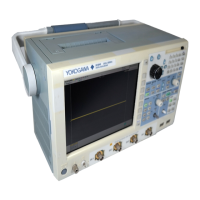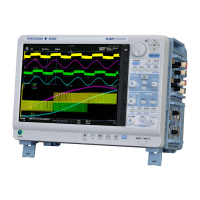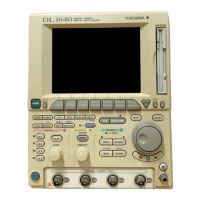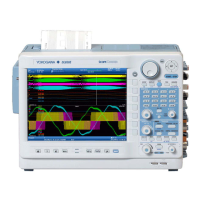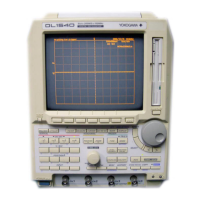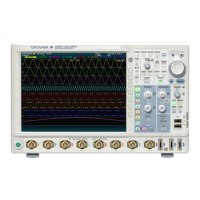2-26
IM 701310-01E
2.8 Analyzing and Searching
Cursor Measurements ►For the procedure, see section 10.1
Cursors can be placed on the displayed waveform from signal data held in acquisition
memory (within the range of the display record length - see Appendix 1), and various
measurement values at the intersection of the cursor and waveform can be displayed.
There are six types of cursor.
Horizontal Cursors
Two broken lines (horizontal cursors) are displayed parallel to the horizontal axis, and
the Y-axis values at the cursor positions can be measured. The level difference between
cursors can also be measured.
A computation formula using the cursor measurement values can also be set, and the
result displayed.
Vertical Cursors
Two broken lines (vertical cursors) are displayed parallel to the vertical axis, and the
times from the trigger position to each vertical cursor, the time difference between the
vertical cursors, and the reciprocal of the time difference can be measured.
A computation formula using the cursor measurement values can also be set, and the
result displayed.
H&V cursors
The horizontal cursors and vertical cursors are displayed simultaneously.
VT cursor
A broken line (VT cursor) is displayed on the vertical axis, and the time from the trigger
position to the VT cursor, and the VT cursor position measurement value are displayed.
A computation formula using the cursor measurement values can also be set, and the
result displayed.
Marker Cursors
Four markers are displayed on the selected waveform. The level at each marker, the time
from the trigger position, and the level difference and time difference between markers
can be measured.
A computation formula using the marker measurement values can also be set, and the
result displayed.
Serial cursors
A broken line (serial cursor) is displayed on the vertical axis, showing a two-valued
function of the waveform from the cursor position, according to the bitrate, bit length, and
threshold settings.
